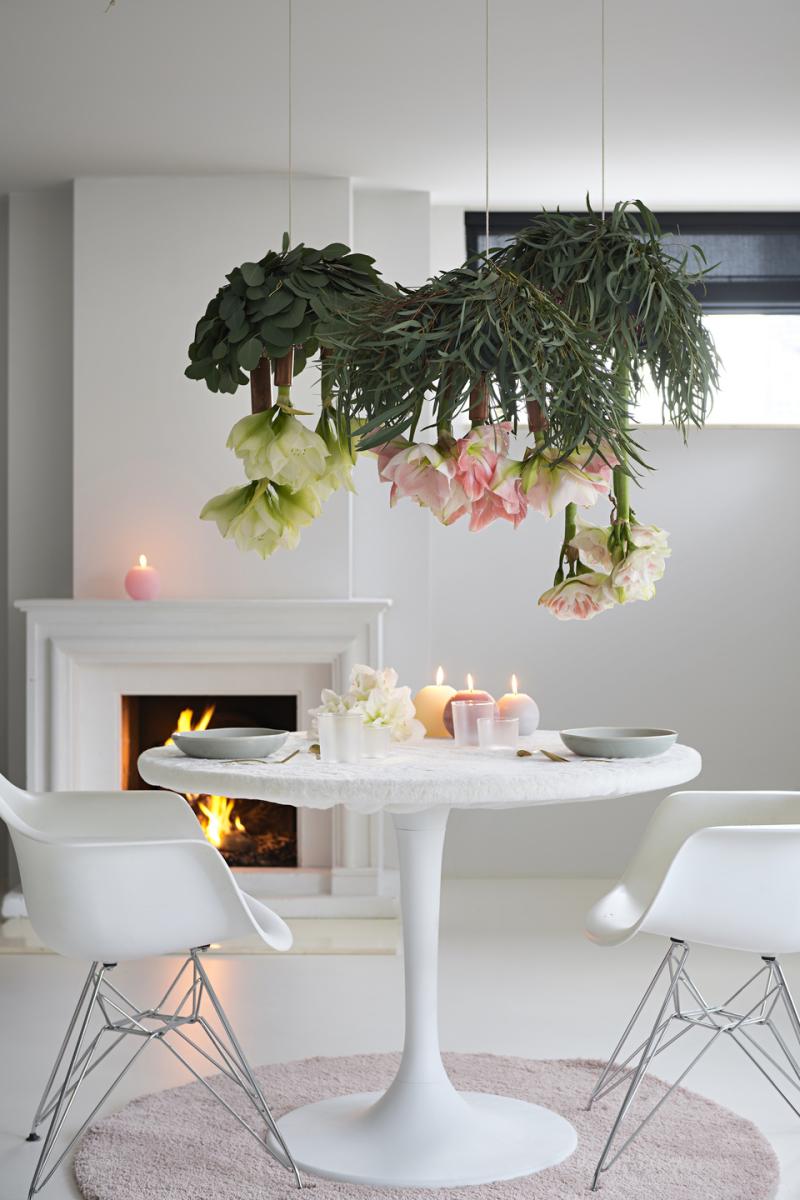Amaryllis: in the December Flower Agenda
Amaryllis is a classic statement flower: large, distinctive and stately. You simply can’t overlook it - the smooth, thick, hollow stems are too unusual for that, and the flowers are too eye-catching. Amaryllis’ petals are very special: they look like they’re made of luxurious velvet and come in white, red, yellow, pink, salmon, purple, orange and bi-coloured.

Origin
The amaryllis as we know it originates from South and Central America and the Caribbean, is a member of the Narcissus family and grows from a bulb.
Amaryllis or Hippeastrum?
What we call amaryllis is actually called Hippeastrum. The name Hippeastrum comes from the Greek and literally means 'knight star', referring to the star-shaped petals: hippeus = knight and astron = star. But because everyone knows the flower as the amaryllis, the names have become synonymous. In the marketing the choice been made to use the more familiar ‘amaryllis’.
Range
The best-known amaryllises are the large-flowered cultivars of which a particularly beautiful range has been bred. Not just red or white in single or bicoloured varieties, but also fabulous claret, purple, pink and salmon flowers. Less well known are the small-flowered varieties that still offer innumerable possibilities in bouquets and floral work. There are various groups within the genus based on flower shape: Galaxy Grp, Diamond Grp, Colibri Grp, Double Galaxy Grp, Double Diamond Grp, Double Colibri Grp, Butterfly Grp, Trumpet Grp and the Spider Grp which includes the attractive Cybisters with orchid or spider varieties.
What to look for when buying Amaryllis
- Check the length and the number of buds per stem.
- The stage of ripeness is expressed in stages from 1 to 5. Amaryllises in stage 1 are usually offered dry in boxes. It is important that the flowers are then stored cool in order to prevent ripening.
- When buying amaryllis it is important that the flowers are free of pests and diseases. The flower can sometimes also show botrytis (= blight or grey mould). The sepals may also be wilted, dried or shriveled or become glazed and/or discoloured because the humidity is too low and they have been stored too long. The stems are sometimes weak (bending coefficient), snapped or dried out. This is usually due to the flowers being stored for too long or being of a poor quality.
- Occasionally there are red stripes along the stem, the so-called ‘fire stems’. This has no negative impact on the lifespan.
Care tips for professionals
- Trim 3-5 cm off amaryllis stems with sharp secateurs or a sharp knife.
- Place the stems in clean buckets or vases with clean water with a preservative added, preferably one specially intended for bulb flowers. A preservative ensures that the flowers open well and that the water is not contaminated by bacteria.
- Ensure that the flowers cannot get damp due to excessive humidity or from condensation. This will encourage botrytis, a fungus which rapidly diminishes the decorative value. With amaryllis this is often called leaf spot or blight because of the small spots on the flowers.
- When creating bouquets and floral work it’s a good idea to insert a support into the hollow stem which can help to support the heavy flowers. This is only necessary with older cultivars - the new range has stronger stems that can stand independently.
- In order to prevent the ends of the stems from curling, the stem can be wrapped in tape or an elastic band. The flower will then continue to take up water better.
- The curling can also be made part of the arrangement: cut the end of the stem into thin strips and place it in very cold water to create a mass of curls in the vase.
- When working with amaryllis in oasis it’s a good idea to prepare the hole before inserting the flower.
- Amaryllis can be stored dry in boxes in the cold store at 8-12°C. It’s not a good idea to store them any colder - that will make the flowers glaze. The shorter the storage period, the fresher the product and the longer the vase life.
- In order to prevent the flowers and leaves from wilting or turning yellow, it’s a good idea to trim the flowers again after a few days and place them on a shallow layer of water with a preservative.
Display tips for professionals
Amaryllis fits perfectly into the style trend in which the home environment is softened and flowers act as buffers. Hang them upside down as a blooming chandelier: the water can be poured into the stems which can simultaneously serve as mini vases for other flowers. Or arrange them as a flowering mini garden. However you use them, the flowers have impact and mute stimuli and noise with their size. In order to reinforce this effect it’s best to opt for the pastel colours with a single orange amaryllis, and place several amaryllises together.
Care tips for customers
- Trim the stems diagonally.
- Select a sturdy glass vase.
- Make sure that the vase is nice and clean, fill it with water and use cut flower food for bulb flowers.
- Place the vase in a reasonably cool spot, not in a draught or next to the fruit bowl.
- Regularly top the vase up with tap water.
Inspiration & information
Inspiring images of every flower on the Flower Agenda have been produced in line with the Horticulture Sector Trends 2019 (Groenbranche Trends 2019). These trends are a translation of the latest consumer trends and are specifically aimed at the horticulture sector for use both indoors and outdoors. If you would like to find out more about the Flower Agenda read more here.
Amaryllis is in the Flower Agenda in December
You can download and use these inspiration images free of charge if you credit Funnyhowflowersdothat.co.uk.
Instagram: @howflowersdothat
Facebook: @funnyhowflowersdothat
Twitter: @flowersdothat





